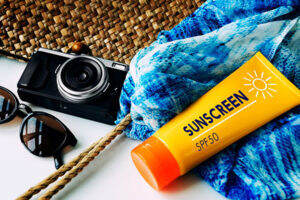Decoding Your Sunscreen Ingredients

So the question is not should you wear sunscreen, but which type of sunscreen you should be wearing. There are two categories of sun protection: Physical and chemical. Physical sunscreens are either zinc oxide or titanium dioxide, both of which are mineral-based and physically prevent UV rays from coming into contact with the skin. Chemical sunscreens on the other hand, absorb UV rays and can take a little longer to work, which is why you need to apply a chemical sunscreen to the skin at least 30 minutes prior to heading outside.
Other than the differences between physical and chemical sunscreens, there are some other crucial things to know about the ingredients found in SPF.
What is the most important attribute to look for in a sunscreen?
The bottle should read “broad spectrum,” which provides coverage of both UVA and UVB rays. Both UVA and UVB rays contribute to skin cancer formation, and UVA is strongly implicated in premature skin aging.
Which is better, physical or chemical sunscreen?
As long as it has broad spectrum protection, blocking UVA and UVB rays and an SPF of at least 30, the type of formulation is up to you. The sunscreen you choose should be pleasant to wear because if you don’t want to wear the sunscreen, even the best ingredients won’t work.

Are there certain skin types that should avoid or look for specific ingredients in sunscreens?
If you have sensitive skin, a a physical blocker or combination formulation that has low irritant potential is best. If you have ever felt “stinging” from chemical sunblocks, a physical blocker might be more tolerable. For those with hyperpigmentation, certain sunscreen formulations have niacinamide or niacin in them, which may help prevent melanosome transfer to keratinocytes and improve superficial pigmentation.
What are some benefits of a mineral/physical sunblock over chemical sunscreens?
Physical blockers may have better longevity if patients aren’t prone to reapplication. You can touch up liquid or lotion sunblocks with mineral sunblock powders throughout the day, because often people don’t want to put on sunscreen, makeup, and then sunscreen again for reapplication purposes.
Other important sunscreen tips to remember
Two of the most forgotten areas on the face when it comes to applying sunscreen are also the easiest areas to burn: Ears and your lips, so don’t forget those two spots. Also remember that just one sunburn greatly increases your risk of developing skin cancer. Be safe this summer and your skin will thank you!
